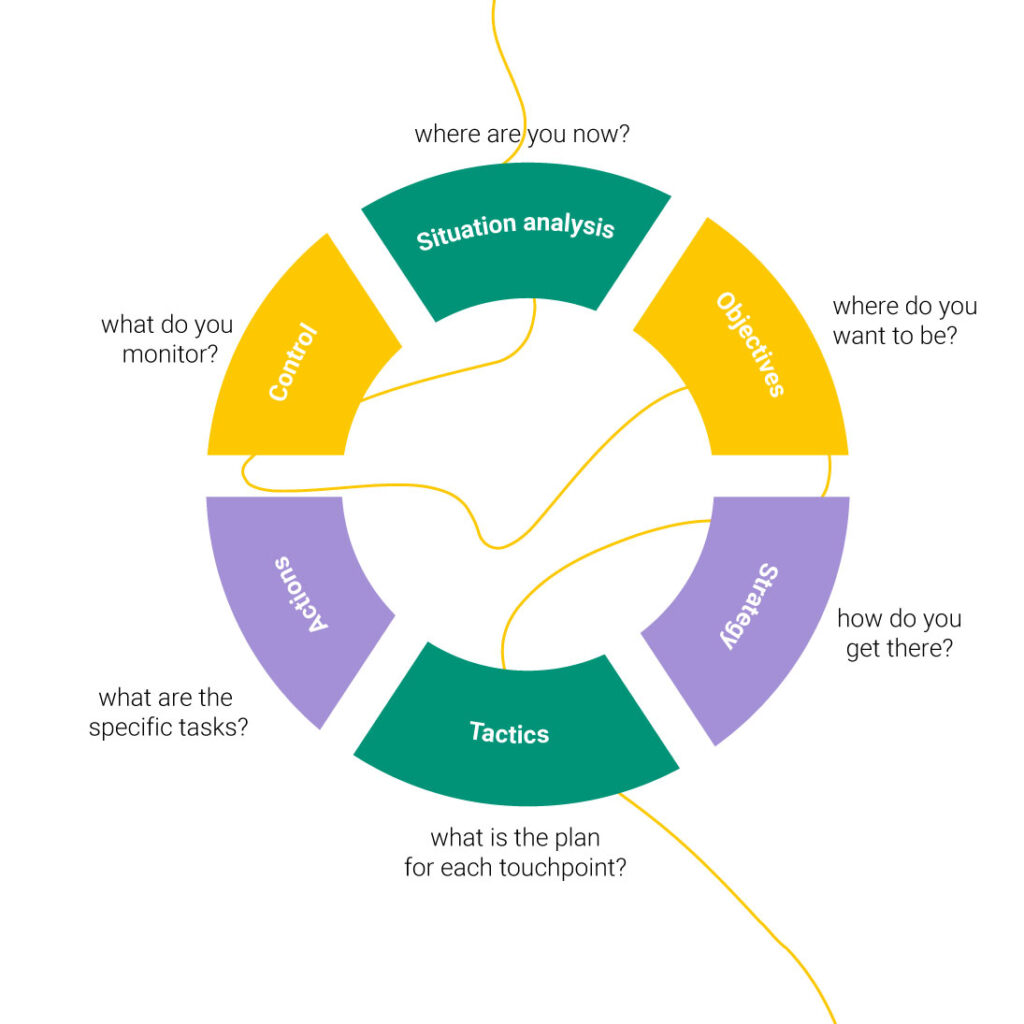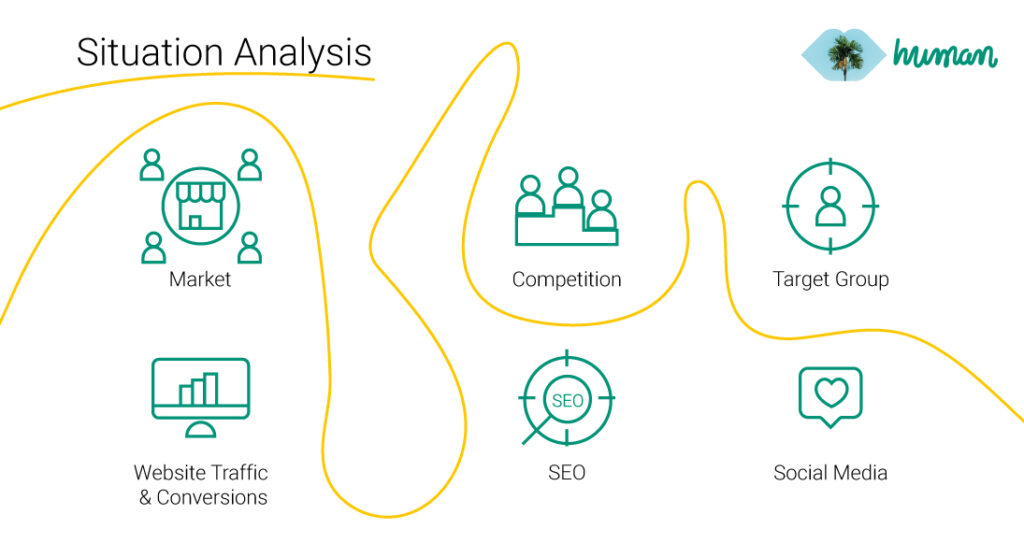Here’s a scenario: you hire an advertising agency to create a marketing strategy for your brand or a product. After three weeks of waiting, you get a 20-slide presentation covering the general marketing strategy, for which you have to pay a lot of money. You feel that something’s missing. All this time and money wasted on this? You’ve spent three weeks waiting only to feel frustrated, disappointed and even deceived. You want them to make “necessary” changes and expansion to make a “proper” strategy presentation.
Why is that? Is the company you hired slacking off? Not quite so. Actually, the marketing strategy team had put a lot of effort into breaking down the complex aspects of the marketing into easily digestible pieces. It takes a great deal of work to distil all the data available into these slides. You may still be irritated as you want to see all the results you’ve paid for. However, the truth is that you are paying the marketing agency for thinking how to convey all these complex information. Drawing conclusions from data and planning the next steps in marketing activities takes time.
In this article, I want to show you the ins and outs of what you are really paying for when hiring the marketing strategy team.
What is the marketing strategy?
There is no universal blueprint for a marketing strategy. If it existed, you wouldn’t need to pay for it. Every business, product and consumer is different. You need to employ a unique approach each time you analyze and plan your marketing activities. But it’s equally important for every business – B2B, B2C, global companies, startups, brick-and-mortar and online enterprises.
The marketing strategy deals with long-term planning of marketing activities for the product or service. By defining the company’s goals, it creates a solid foundation for further marketing activities of your brand. A good marketing strategy document puts your brand in the context of the market and the competition.
What are the elements of the marketing strategy?
One of the most useful frameworks to use with your company marketing is SOSTAC model. Developed by PR Smith, it was proven useful for working with marketing and business cases. SOSTAC acronym stands for:
- Situation analysis – where are you now?
- Objectives – where do you want to be?
- Strategy – how do you get there?
- Tactics – what is the plan for each touchpoint?
- Actions – what are the specific tasks?
- Control – what do you monitor?
Many high-ranking executives from the C-level focus on the last two of these points. But we should remember that these are the final steps of the longer journey. The stages from Situation Analysis to Tactics are equally important for creating a consistent and working marketing strategy (and further success) as the final ones.
Research and analysis are the key aspects of the marketing strategy preparation. The data is everything. Without numerical information you cannot assess your current position and results. Moreover, you cannot extrapolate the future results for your marketing activities. The company’s marketing strategy based on data is more relevant, more stable and simply – more useful.
Let’s take a closer look at the first analytical part which is crucial for the creation of a successful marketing strategy.

Analyzing your current marketing situation
Let’s say that you want to take a trip to a specific place. You will need the target destination, the means to travel and the map or directions to get there.
Of course, you can make it harder (or more fun) by not accounting for one or more of these things. You can take a hike or go hitchhiking, but it will take more time. You can drive aimlessly, but you will waste more gas and you cannot be sure when you will end up. You can ask people for directions on your way, but you risk getting lost, taking a wrong turn or being misled on the way.
If you want to take an extended, one-year, lone trip around the world, things get even more complicated. You need to assess your supplies and budget, do extensive research on the places to stay and visit, and prepare the necessary documents and equipment. These preparations take a lot of time. No planning or supplying (not taking the necessary precautions, formalities, tools or outfits) can result in several consequences ranging from minor nuisances to things preventing you from a further journey.
The same goes for the marketing strategy and your business. If you want to achieve market success in the long run, you cannot focus on makeshift solutions and hunches. You need a solid foundation to build your omnichannel brand presence on. There are no shortcuts. The strategy team needs to understand your brand, product or service as well as your customers.
The strategy presentation is one of the most important pieces of documentation in your company.
Why is it so short? It may consist of a limited number of slides, but these are the crucial highlights coming from the diligent work – the insights resulting from extensive research. These 20 slides don’t cover your whole marketing strategy. This presentation is just a readable extract of knowledge prepared to be read by the decision-makers in your company and to be passed on to everyone in it. You need a piece of information that is easily understandable and applicable for everyone in your firm. It’s a blueprint for all of your marketing activities and it connects all of the aspects of your business: product, branding, advertising, sales and customer experience.
As a marketing strategist, I keep your business goals in mind. I want you to succeed. When your business grows, I have it to my credit because it was done with my help. Therefore, I act in your best interest. Using the insights coming from the analysis, I will point out the areas worth investing in. And, even more importantly, what approaches are not worth trying. The analysis may lead to some harsh truths, but challenging the status quo is part of the marketing strategist’s job.
What does the marketing strategy analysis consist of?
The marketing strategy groundwork is, above all, the analysis. Without knowing where you stand, there is no possibility of making progress. The sources analyzed for the marketing strategy include studies, industry reports, statistical data provided by independent and government bodies, etc. It’s a lot of information to process, and it takes time. The situation analysis step is made of, but not limited to, the following elements.
Market research
“My product is so unique there’s nothing similar and we don’t need to do market research”. This is a trap many entrepreneurs have fallen into (I’ve seen it!). Even if your idea is truly unique, you are still a subject to market constraints. For example, if you developed a luxury product, you should analyze the market for such items, using benchmarks from industries like fashion, automotive, watches and jewellery. These analyses surely will bring the insights that will help you launch the product and sell it later on.
The current situation in your industry affects what you can do when it comes to marketing activities. You need to carefully analyse your business environment and look into the recent trends. There may be a crisis approaching, or the contrary – the business is going to be booming, so you need to take on the biggest slice of the market. All the individual aspects of your industry must be accounted for in the marketing strategy.
Competition analysis
“My product is so out of this world, that it sells itself”. Well, there are many cases of truly great products which have lost to aggressive competitors. They were selling worse products but used clever marketing tactics and promotion. If you are not monitoring the competitors, you are more likely to lose your market share. It is good to know what they are doing so you will not be surprised by their actions. You can employ countermeasures according to the behaviour of your competing businesses.
Your business doesn’t exist in a vortex. You need to know the strengths and weaknesses of your company and how they relate to your competition. How do the competitors build their brands? What marketing activities do they employ? What are their strongest suits? How can you compete with them in pricing or quality of service? The competition analysis can also inspire us to take the relevant steps to counter their activities or tap into the emerging trends in the business.
Target group analysis
“My target group includes everyone who uses my product.” That information doesn’t carry any meaning. What are your customers really like? Are they well-off or rather struggling? What do they aspire to? How does your product make them feel? The customer personas are not created just for the sake of it. These are the constructs allowing you to connect with your audience. They are based on data, research and interviews with your clients. I have seen the consequences of targeting the wrong audience. The money was burned for the campaign but the results were underwhelming.
Satisfying your customer’s needs is the key to success. Easier said than done. To provide for it, you need to understand your customer first. It is not an easy task, there’s no simple solution.
To understand your target audience well, you may need to employ various approaches, as well as quantitative and qualitative research. For example, Focus Group Interview (FGI), Computer Assisted Web Interview (CAWI), Individual In-depth Interview (IDI) etc.
In the case of a B2B marketing strategy, you may want to conduct interviews with your current clients or these who have chosen the competitor at the final stages of the selling process. Your sales team may provide valuable insight into your clients’ minds because of their first-hand experience. The customers may be more eager to share their doubts or fears with the sales consultant than with the researcher.
The data gathered from this research must be processed and presented in the form of clear information, easy to grasp by everyone in your company. This may take the form of buyer personas or customer journey maps showing the touchpoints where your client interacts with the brand.
Website traffic and conversions analytics
“No one ever visits our website.” That would be true if the website was not designed well. People will look for your brand on the Internet, regardless of whether you want it or not. And their actions on your website will tell you a lot about them. Is the content you publish there engaging enough? Do the users ever scroll down? Do they get frustrated by the loading time and quit? I can extract a lot of useful data about your clients just by looking at the basic analytics panel.
Even though your business may not be online-based, you still need a website. Your business page is a place for clients to gather information about your company. If you’re entirely offline-based (you’re running a restaurant or a service point), you still need an online presence but with the use of a different approach. You need to know how your customers interact with your website and if they can find the information that they are looking for. If you have developed a mobile app, the in-app analytics matters even more.
As digital channels provide us with extensive data on user’s behaviour, we have a lot of information to process. The analytics can also show us the most important channels generating traffic (organic, referral, social, paid). If you track conversions (like sales) on your website, you may get valuable information on the user’s behavioural patterns. Even if your business is not focused on digital marketing, you still may want to create a useful website to account for this channel.
SEO analysis
“Why to bother with search engine optimization? We don’t sell through the website.” But you still want to be visible on the net, don’t you? Your ranking in the results pages is an important factor in building trust and position of your brand-related content. Even if you don’t have an e-commerce subpage, you still should attract customers by providing them with answers to their problems. Your product should be a solution popping out in search results when they type in the relevant question.
Getting found via the search engine is one of the more important elements of the brand’s online presence. It can be done by investing in sponsored links. But investing time and money in consistent search engine optimization can reap bigger rewards in the longer time perspective.
You need to assess two aspects of your SEO: technicalities and content. Technical SEO, in brief, is a set of rules for coding your website. Proper tagging gives your website a boost in positioning because you guide the engine robots through your pages. Backlinks bringing traffic from external, trustworthy sources also improve your position in SERP (Search Engine Results Page). The loading time and overall user experience, especially on mobile browsers (Search Experience Optimization – SXO) also play an important role.
The next part – content – is getting increasingly important since users search for information online. If you give them relevant, clear and engaging answers to their questions, they are more likely to choose your brand over others. Keyword research and positioning are also important statistics to build your content marketing strategy on. It will list the phrases that the users really type in the search box when looking for your products and services. You may use this information and focus on improving your content on the website, consequently getting more visits through organic search.
All of the factors mentioned above greatly affect your brand’s online presence. And they need to be accounted for in your digital marketing strategy.
Social media presence analysis
“Let’s go viral on Tik Tok!” Social media presence is seen by many as the cheapest way for engaging with your audience. True. But it’s a crammed environment. Your brand message may not push through the clutter. Your posts should be published regularly. They should be original, eye-catching and engaging. Consistency is key to growing users’ base on social platforms. Are you ready for the demanding groundwork of planning, designing, writing and posting on a day-to-day basis? Are you sure that specific social media channel use is prevalent in your audience? If not, you might have been burning through your resources trying to appease the people who won’t even buy your product. Facebook, Twitter, LinkedIn, Instagram, YouTube, and even TikTok are important platforms to connect with the brand’s audience.
Depending on the customers you want to attract, the social media channels relevant to your promotion may differ. The strategist analyses the current brand’s social media presence as well as the competitor’s activities. Social media listening tools may provide useful for finding out how your brand message resonates with the audience as the marketing strategy points out the channels where the user will most likely engage with your brand. You need to check if your social media activities truly affect your sales and user engagement. If not, you may want to switch to the channels that work best for spreading your brand message.

Why does the marketing strategy preparation take so much time?
Conducting the research, analyzing the results and putting them into a broader perspective as well as coming up with relevant insights is tedious but important work. All of the analytical activities mentioned before require a lot of time and resources but omitting them will result in falling into pitfalls and dead ends during your journey to success.
The results can be applied to all of your marketing strategy building blocks, like brand strategy, communication strategy, digital marketing strategy, content marketing strategy, and others. The market analysis results are a starting point for setting up the goals (KPI), channels (marketing mix) and marketing budget.
We have taken a peek behind the scenes of the strategy preparation. Unfortunately, a lot of this work remains hidden from the viewer. In my opinion, the biggest part of a marketing strategist’s job is research and analysis. If you know where you stand as a brand, the goals to reach will come naturally.
Let’s get back to your one-year trip around the globe. You have conducted extensive research on the places you want to visit and evaluated the quality of your resources. Now it’s time to plan the whole itinerary in detail and to make the necessary arrangements. In the following articles, I will go through the next steps of the marketing strategy journey.






